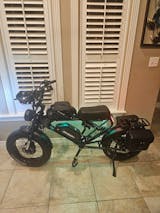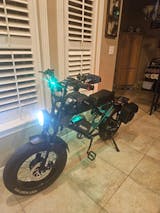Table of Contents
- What Is an Ebike Range Calculator?
- Factors That Affect the Range of an Electric Bike
- Battery Capacity
- Speed & Assist Levels
- Terrain & Elevation
- Rider Weight & Cargo Capacity
- Weather Conditions
- Step-by-Step Guide to Using an Ebike Range Calculator
- Pro Tips to Extend Your Ebike's Range
- Make Use of Lower Pedal Assist
- Properly Inflation Tires
- Avoid Rapid Acceleration
- Plan Routes with Minimal Stops
- Charge Your Battery Correctly
- Conclusion
- FAQs
Understandable ride preparation becomes possible by having information about your electric bicycle's maximum distance after recharging. Knowing an ebike range calculator becomes essential when your riding area lacks charging stations because running out of power unexpectedly can lead to getting stranded.
An ebike range calculator determines your traveling distance through analysis of battery watt-hours (Wh) and speed and terrain type and power use data. Having entry points for the necessary details enables precise predictions regarding ebike mileage between charges.
Many factors affect ebike battery efficiency. Riding at higher speeds depletes power faster, while pedal assist modes extend range. Hilly terrain drains power more quickly while weather conditions and rider weight also play a part. Understanding these elements allows you to optimize your ebike's range and plan longer rides with confidence.
What Is an Ebike Range Calculator?
The ebike range calculator serves as a valuable resource to estimate electric bicycle range performance based on analyzing the impact of battery watt-hours (Wh), riding efficiency levels and energy use per mile alongside battery capacity (V x Ah). Riders can obtain exact mileage estimates for their battery charge through additional information about weight together with terrain conditions and pedal assist settings.
This tool helps prevent battery drain issues by allowing riders to plan long-distance ebike rides with confidence. Instead of guessing your remaining range, this tool helps riders monitor how riding speed, power usage and road conditions impact performance - helping ensure you won't become stranded far from a charging station.
Bosch and Giant offer popular range calculators online that offer estimates. Furthermore, some electric bikes feature built-in range predictors which provide real-time calculations based on your current riding conditions - this helps riders make smarter riding decisions, extend battery life and experience more efficient journeys.
Factors That Affect the Range of an Electric Bike
Many factors influence how far an ebike can travel on one charge, making understanding these components of importance to optimizing battery efficiency and planning longer trips without fear of battery depletion more effective for riders.
Battery Capacity
Batteries are measured in terms of both amp-hours (Ah) and watt-hours (Wh). The higher the Wh, the longer your ebike mileage per charge. A 48V 10Ah battery delivers approximately 480Wh; this determines how much energy is available before being recharged.
Speed & Assist Levels
Riding speeds play a significant role in energy consumption. Traveling at higher speeds or using throttle mode heavily will drain the battery faster; using lower pedal assist levels helps extend range by decreasing motor power usage.
Terrain & Elevation
Flat roads require less energy than hilly terrain, while climbing steep inclines requires additional power, reducing range. Rough surfaces like gravel or sand increase rolling resistance further decreasing efficiency of an ebike.
Rider Weight & Cargo Capacity
An increase in rider weight or added cargo reduces battery drain, forcing the motor to work harder to keep speed. This decreases range per charge.
Weather Conditions
Cold temperatures decrease battery charge cycles and diminish overall efficiency, significantly shortening range by up to 30% during extreme conditions - thus, warm storage storage is essential to protect battery health and ensure its continued performance.
By considering these factors, riders can maximize the efficiency of their electric bike, adapt their riding habits and plan longer rides without experiencing range anxiety.
Step-by-Step Guide to Using an Ebike Range Calculator
Utilizing an ebike range calculator provides an accurate picture of how far your battery will go before needing recharge, so follow these steps for accurate calculations of mileage per charge on an ebike.
Step 1: Collect Your Data
To obtain an accurate range estimate, it is necessary to know your battery's watt-hour (Wh) capacity; this can be calculated with this formula:
Voltage (V) × Amp-Hours (Ah) = Watt-Hours (Wh)
For example, a 48V 10Ah battery provides 480Wh. To get a better idea of energy usage per mile on an electric bike, figure out your average consumption; typically 10-25Wh per mile can be expected depending on terrain, speed and assist levels.
Step 2: Enter Your Ride Conditions
Once you have your battery data, enter additional details into the ebike range calculator: Riding Speed: Higher speeds increase power consumption, thus decreasing range.
Terrain Type: Hills or rough surfaces may require more power than flat roads.
Pedal Assist Mode: Lower assist levels enhance battery efficiency. Tune these factors to see how different conditions affect range. Some range calculators also allow riders to input rider weight and wind resistance data for more precise results.
Step 3: Analyse Your Results
After entering your data, the ebike range calculator provides an estimated mileage estimation per charge. Use this information to:
- Plan long-distance rides without running out of power.
- Adjust riding habits to increase battery efficiency.
- Optimize routes by choosing terrain that conserves energy.
With this strategy in place, you can ride with confidence knowing your battery range has been maximized to provide maximum mileage.
Pro Tips to Extend Your Ebike's Range
Maximizing battery efficiency on an ebike enables you to ride further distances without running out of power, and here are five proven strategies for increasing mileage per charge.
Make Use of Lower Pedal Assist
Modes High pedal assist levels consume more energy by relying on motor power rather than your pedaling, which results in shorter rides with one charge. Switching down assist levels allows for lower battery power usage on flat terrain allowing you to go further on each charge.
Properly Inflation Tires
Underinflated tires increase rolling resistance and force the motor to work harder, rapidly depleting battery power. To ensure optimal efficiency of your ebike ride, check its tire pressure regularly within its recommended PSI range to maintain proper inflation of its tires.
Avoid Rapid Acceleration
Sudden bursts of speed require an inordinately large surge of power, leading to significant energy consumption. Instead of embarking on full throttle starts, gradually increase speed until reaching optimal power efficiency and prolong battery life.
Plan Routes with Minimal Stops
Reducing energy usage involves selecting routes with few traffic signals, minimal inclines and smooth roads in order to increase energy-efficient riding. To maximize energy-saving results when selecting routes this way.
Charge Your Battery Correctly
Avoid fully draining or overcharging your battery as this accelerates battery degradation. Aim for 20-80% battery charging levels when possible and utilize manufacturer recommended chargers to increase longevity of battery use.
By following these tips, you can maximize the range of your ebike, making every ride more efficient and reliable.
Conclusion
A range calculator is essential for accurate trip planning on an ebike. It helps riders estimate how far they can travel on one charge, thus avoiding unexpected battery drain issues. By understanding key factors such as battery watt-hours, terrain type, riding speed, power consumption and battery watt-hours riders can make informed decisions to maximize ebike mileage per charge.
Optimization of your ebike commute habits can significantly extend battery life. By making adjustments like using lower pedal assist levels, maintaining correct tire pressure, and avoiding rapid acceleration, battery efficiency is increased significantly. Planning routes with minimal stops and adhering to proper charging practices further contribute to this result.
By employing these strategies, you can ride confidently and efficiently, making every journey smooth, reliable, and energy-saving. Begin using a range calculator today for worry-free rides!
FAQs
1. How accurate are ebike range calculators?
Ebike range calculators give estimates based on battery watt-hours, terrain and riding habits, though real world factors like wind resistance, rider weight and temperature may cause variations from these estimates. To increase accuracy use a calculator that takes multiple variables into account and track your actual mileage to improve results.
2. Can I increase the range of my ebike without upgrading the battery?
Absolutely. Lowering pedal assist levels, maintaining optimal tire pressure levels, riding at moderate speeds and avoiding throttle-heavy riding can all increase range without an upgrade in battery capacity. Planning routes with minimal stops or inclines also contributes. Regular battery maintenance charging between 20-80% extends life expectancy for longer journeys.
3. Does cold weather impact ebike range?
Yes, cold temperatures slow battery charge cycles and reduce efficiency; freezing conditions can decrease range by as much as 20-30%. To minimize impact, store batteries in warm environments before use; preheating is also beneficial; long rides in extreme cold are to be avoided whenever possible.




















